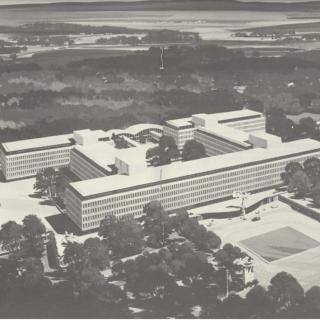The Pentagon Goes Up in Flames, 1959
The call came in to the Arlington County Fire Department at 11:16am on July 2, 1959… The Pentagon was on fire.
ACFD units raced to the scene, soon to be joined by deployments from 34 other jurisdictions including Falls Church, Alexandria, Fort Myer, the District, Prince Georges County, Bethesda and the Inter-Agency Government Pool — over 300 firefighters in all.[1]
When trucks reached the scene, black smoke hung over the building, so thick that they had to form a human chain in order to navigate. Firemen groped, clawed and cut their way to the blaze, which had erupted in the Air Force statistical services offices between rings C and D and corridors 1 and 10.[2]
Just an hour earlier, that office had been the home to one of the Department of Defense’s most sophisticated war emulators. Now, the scene resembled a “caved-in mine shaft” with torched multi-million dollar computers buried under mounds of charred debris.[2] The stench of burning film and magnetic tape hung in the air and water from the fire hoses sizzled on the floor, “so hot you could feel it through your boots,” according to one fireman.[3]
It wasn’t until after 3pm that the flames were out and officials could start assessing the damage.
The data center was a total loss. IBM (which stands for International Business Machine, in case you didn’t know) told Pentagon officials, “Take everything that belongs to us and send it to the Government dump.”[4] (In those days, the Pentagon leased its computers from IBM rather than purchasing them outright. Fortunately for IBM, the ruined equipment was insured.)
In addition, 7,000 acetate magnetic tapes with classified Air Force information had gone up in flames, though the Pentagon was quick to say that everything important to national defense was safely stored in other data centers. Officials also made a point to reassure the public that the fire had not caused a security breach. “Before personnel of the center left their offices, they performed a regular civil defense operation—they cleared their desks, locked and checked their safes, and departed. Armed Air Policemen rechecked the safes and remained on guard duty.”[2]
For the record, the Evening Star offered a slightly different assessment: “Government security reigns—but not when the Pentagon is on fire…. For the sake of emergency a number of corridors usually guarded by military police were as open to reporters as they were to the 300 firemen. Everyone went about his task, generally ignoring signs.”[5]
GSA and Pentagon officials worked quickly to relocate the several hundred employees displaced by the blaze. Many were transferred to Bolling Field where a makeshift office was setup in an airplane hangar. As the Star said a couple of days after the fire, “Come Monday, the military and civilian workers will be sitting in front of brand-new desks facing a T-29 navigation training plane, which occupies the other half of the hangar.”[6]
Meanwhile the Air Force worked with IBM to get replacement computers as quickly as possible. Col. Marshall R. Gray told the press, “It usually requires 12 months or more to deliver the big computers. However, the full co-operation of other Government agencies and private industry has cut this time to 15 days.”[7] Within a few days, IBM delivered a brand new 709 Data Processing System.
With the recovery underway, Pentagon and Arlington Fire Department officials tried to determine the cause of the fire. At first it was chalked up to an “electrical defect” in the tape and storage room of the Air Force office.[1] Later, GSA officials traced the blaze to a temporary light bulb, which had been left burning by a workman. The heat of the bulb caused the fiberboard ceiling to catch fire.[8]
According to Arlington Fire Chief Joseph Clement, it was an accident that had been waiting to happen. “When the Pentagon was built 16 years ago, it was about as fireproof as a building can be made. Since then, however, they have honeycombed it with wooden partitions and floors and ceilings of other combustible materials.”[9]
Thankfully, no one was killed as a result of the blaze, though over 30 firefighters were hospitalized. In terms of property damage, the fire claimed at least $690,000 worth of Government-owned property and many millions worth of IBM computer equipment. It was the biggest and costliest fire incident at the Pentagon until September 11, 2001.
For more on the 1959 fire, check out the Arlington Fire Journal blog.
Footnotes
- a, b “5 Alarm Fire Rages in Pentagon,” Evening Star, 2 Jul 1959: A1.
- a, b, c “Probers Seek Cause of Big Pentagon Fire,” Evening Star, 3 Jul 1959:B1.
- ^ “Company of Heroes: Story of Rescue Squad 1,” Evening Star, 3 Jul 1959: B1.
- ^ “Probers Seek Cause of Big Pentagon Fire,” Evening Star, 3 Jul 1959:A1.
- ^ “Fire Melts Away Barriers to Secret Defense Files,” Evening Star, 3 Jul 1959: B1.
- ^ “Hangar Fitted to Serve Homeless AF Staff,” Evening Star, 4 Jul 1959: A16.
- ^ “Steel Planned for Burned Pentagon Walls,” Evening Star, 8 Jul 1959: A10.
- ^ “Pentagon Fire Property Loss is $690,000,” Evening Star, 4 Aug 1959: B8.
- ^ “34 Minute Lag on Pentagon Fire Charged,” Evening Star, 4 Jul 1959: A16.





![Sketch of the mythical fuan by Pearson Scott Foresman. [Source: Wikipedia]](/sites/default/files/styles/crop_320x320/public/2023-10/Goatman_Wikipedia_Faun_2_%28PSF%29.png?h=64a074ff&itok=C9Qh-PE1)












